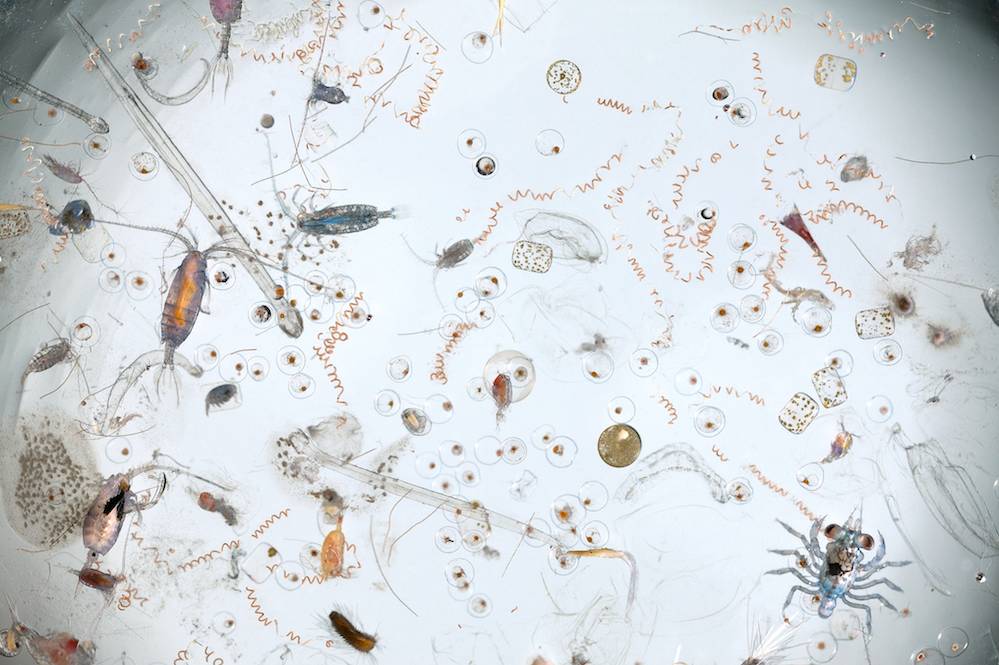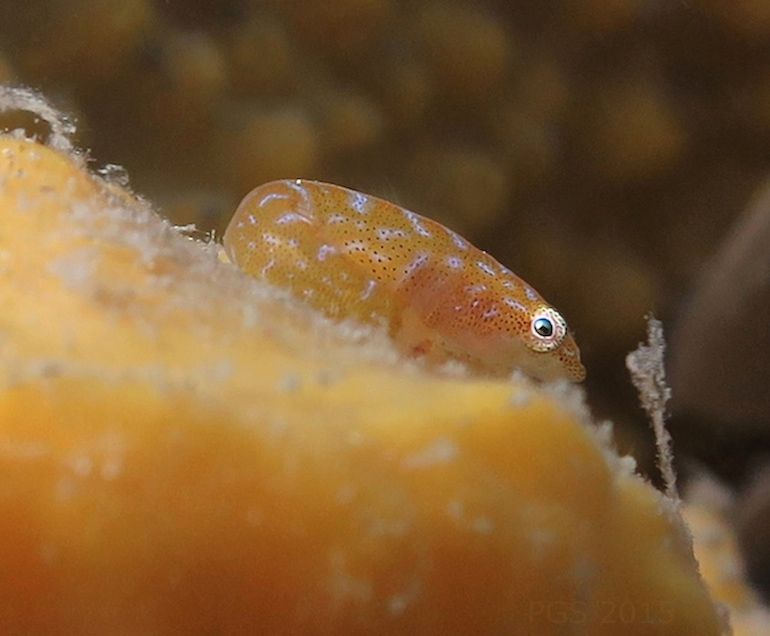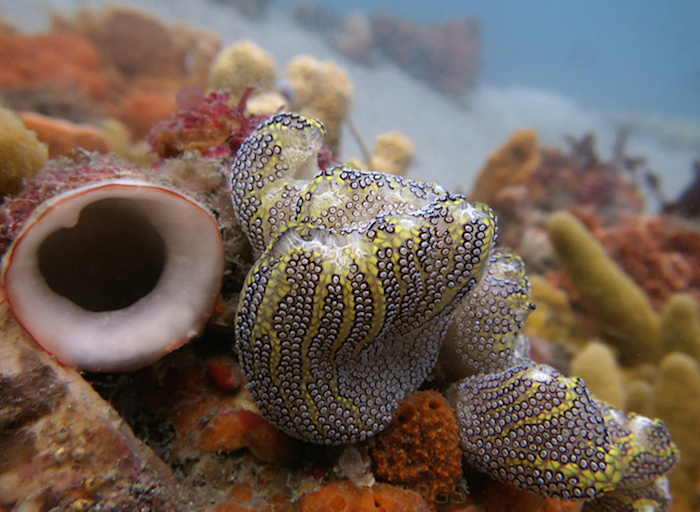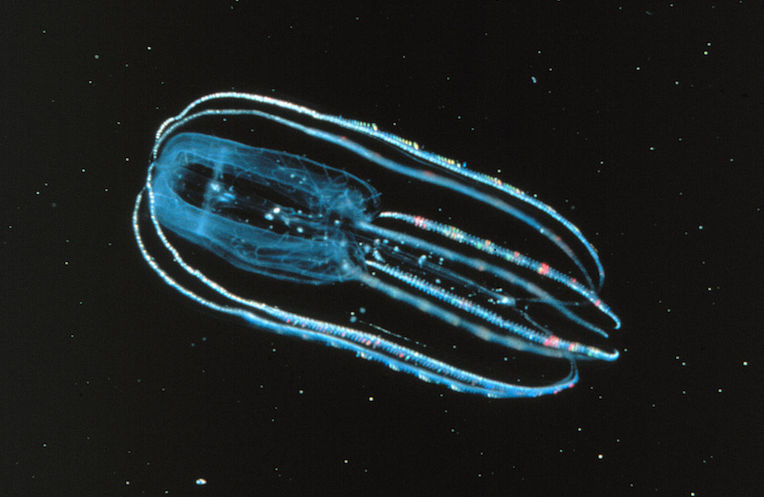The photograph above was taken by David Liittschwager for a project with National Geographic. Years ago it was also published in the Guardian newspaper, where I saw it while staying for some months in Manchester, England, far from the ocean.
The original caption in the magazine reads: “Under a magnifier, a splash of seawater teems with life. The planktonic soup includes bug-like copepods; long, glassy arrowworms; coiled filaments of cyanobacteria; rectangular algae called diatoms; fish eggs; and a big-eyed larval crab the size of a rice grain.” The image was taken on board the NOAA Ship Oscar Elton Sette off Kona, Hawaii, in 2006. David writes: “The sample shown is a portion of the contents of a single dip of a hand net. The total volume of the concentrated portion show in the picture is less than ten drops.” Thanks to David for permission to use his image here.
This post is the first of a few about current work on the early history of animals, especially about three stages in that history: the evolution of the first multicellular organisms in the animal lineage, the evolution of the first nervous systems, and the evolution of bilaterally symmetrical animals (animals with a left and right) like ourselves. All three events are so deep in the past, 600 million years and beyond, that enormous uncertainty surrounds them. There was a cautious and partial consensus about the first two for a while, but it’s now very much in doubt. Over the past year I’ve been to two conferences about these questions, one in Tübingen, Germany, at Gáspár Jékely’s lab, which I wrote about in November, and the other in March, in London at the Royal Society. Last week I went back to reading about these questions, and found that the scene has changed a bit even since March. In this post and some others I’m going to sketch and summarize and think things through. I write not as an expert in this area, only an obsessive. At the Tübingen conference I did offer some thoughts on the biology, though, and I’ll do that from time to time here. There were also moments at the Royal Society conference in England when I thought that speakers were rather reluctant to sketch speculative views of the big picture, the likely overall shape of the story. They stuck to their data, to what is known. Without in any way criticizing that attitude, I’ll range a bit more widely.
As I’m discussing the evolution of all animals, the photos will wander through the phyla. Here we have: fish + sponge.
The view I called a partial consensus, or at least the most established option, goes like this. Of living animals, sponges are the ones furthest from us in evolutionary terms: the branching in the tree of life that leads on one side to sponges and on another to us is deeper than any other branching within the animals.† One interpretation of this – not the only one – is that we have ancestor who lived somewhat like a sponge, fixed to the sea floor and with no nervous system at all. Sponges seem an unlikely basis for the evolution of active lives, but that’s only true of the adults. The juveniles, the tiny larvae, are swimmers. Perhaps, then, the line that led to other animals begins with a sponge larva who refused to settle and transform into the adult form. As Claus Nielsen has put it, we and other animals might all be “derived sponge larvae.”
Just because sponges are furthest from us does not imply that we have an ancestor who looked like one. A present-day sponge is the product of as much evolution as we are. So initially, there’s no reason to think the ancestor looked more like them than like us. But other factors come into play. If we look within the sponges, there are old evolutionary branchings that lead on both sides to a sponge-like sort of organism, and there are also fairly old sponge fossils. Accordingly, Nielsen in 2008 published this figure summarizing one story about the evolution of animals and the origin of nervous systems:
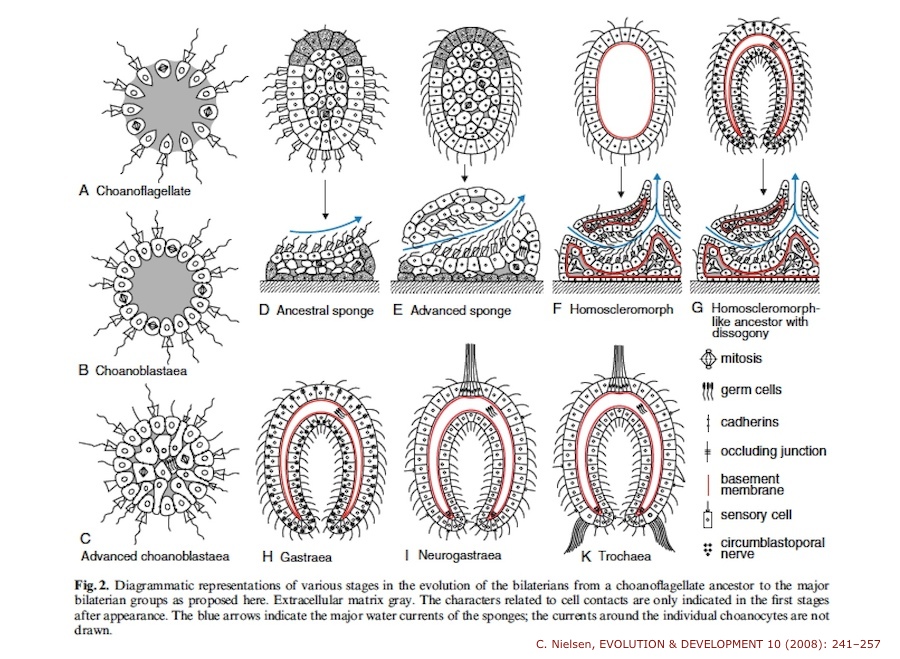 From a colonial ball of choanoflagellate cells (A, B) we pass through a series of sponge and sponge-like forms, with both adults and juveniles evolving (D-G), before the larvae abandon the adult stage, evolve a nervous system, and eventually give rise to bilaterally symmetrical animals like us (and our relatives, the ascidians below).‡
From a colonial ball of choanoflagellate cells (A, B) we pass through a series of sponge and sponge-like forms, with both adults and juveniles evolving (D-G), before the larvae abandon the adult stage, evolve a nervous system, and eventually give rise to bilaterally symmetrical animals like us (and our relatives, the ascidians below).‡
Nielsen’s is one particular development of the older mainstream view, not the only one. I admire the way he makes all the steps explicit in his 2008 paper. Against this background, though, it came as a surprise when genetic data began to suggest that comb jellies (ctenophores, with a silent ‘c’) branched off from the line leading to the rest of animals even before sponges did (as in the picture on the right).
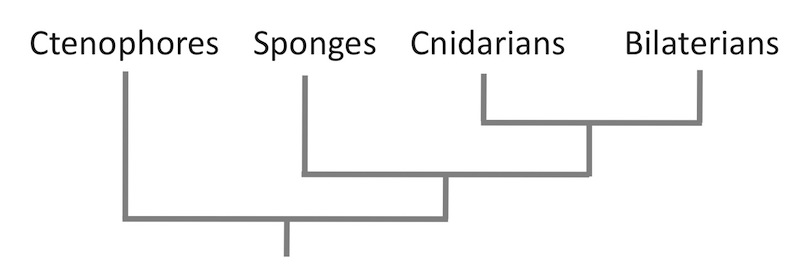 Using more technical language, ctenophores are the sister group to all other animals. This has been argued in a series of papers beginning around 2008, with several coming out in 2013 and 2014. At the conference in Germany last year, the biologists who work on the deep history seemed quite skeptical about this view. At the English conference in February, it was discussed extensively but still with what I saw as much wariness. There are known sources of error that can affect deep-time claims of this kind. Just last month, though, a paper appeared in PNAS that is solely aimed at checking for those sources of error, and working out whether the view that ctenophores are sisters to all other animals stands up when the analysis is done in many different ways, each aimed at excluding different possible sources of trouble. To my non-expert eyes, at least, the new paper looks quite convincing, and it claims that ctenophores are indeed outside sponges on the tree: sisters to all other animals. Has the tide now changed, running with the new view against the old?
Using more technical language, ctenophores are the sister group to all other animals. This has been argued in a series of papers beginning around 2008, with several coming out in 2013 and 2014. At the conference in Germany last year, the biologists who work on the deep history seemed quite skeptical about this view. At the English conference in February, it was discussed extensively but still with what I saw as much wariness. There are known sources of error that can affect deep-time claims of this kind. Just last month, though, a paper appeared in PNAS that is solely aimed at checking for those sources of error, and working out whether the view that ctenophores are sisters to all other animals stands up when the analysis is done in many different ways, each aimed at excluding different possible sources of trouble. To my non-expert eyes, at least, the new paper looks quite convincing, and it claims that ctenophores are indeed outside sponges on the tree: sisters to all other animals. Has the tide now changed, running with the new view against the old?
Here is a ctenophore (from Wiki). They look superficially like jellyfish, and had previously often been grouped with them (in the ‘Coelenterata’ of old biology textbooks).
One reason why people have been reluctant to accept the new view is very relevant to this website. Ctenophores, unlike sponges, have nervous systems. On the old view, nervous systems evolved just once. On the new view, they probably evolved twice, once in ctenophores and once on the line leading away from sponges to cnidarians and animals like us. 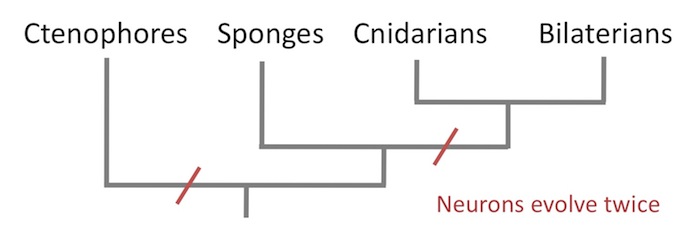 If true, this would be surely the most dramatic and surprising case of parallel evolution yet discovered.
If true, this would be surely the most dramatic and surprising case of parallel evolution yet discovered.
Leonid Moroz has argued for exactly this claim this since 2009, appealing to the differences between ctenophore nervous systems and all others. Ctenophores use none of the “classical” neurotransmitters to signal between cells. Moroz’s 2009 paper seemed impressive to me. I ran it past a neurobiologist colleague back then and she was very skeptical about it. The idea that nervous systems – with recognizable neurons, synapses, and so on – could arise twice has been seen as extremely implausible. But if ctenophores are sisters to all other animals, then either this is true, or the animals without nervous systems, sponges and placozoans, once had them in their lineages and lost them. At the English conference this last option was defended by Joseph Ryan, and it was also seen as quite radical.
If the ctenophores are sisters to all other animals, what should our new picture be of the lives and body forms of the first animals, and animals in which nervous systems arose? What might be a new picture that replaces the Nielsen scenario above? It makes sense to start outlining and working through possibilities. I’ll start with a simple one. This is the possibility that the Nielsen picture can simply be tacked on to the ctenophore scenario. Animals arose, ctenophores branched off and evolved nervous systems for their own filmy reasons, and the lineage that led to us, on which nervous systems evolved again, took something like the spongy path that Nielsen described, still with a special role for juvenile stages. If that’s how things went, then parts of the old view remain intact, with a ghostly addition on the side. Superficially similar nervous systems evolve once in a jellyfish-like animal which swims with cilia, and once in the descendants of a sexually precocious sponge larva.
I’ll follow up some other options in a later post.
________________
Notes
† The Placozoa are another puzzle that has to fit in here somewhere. I assume they are no longer likely candidates for being the sister group to all other animals.
‡ The picture shows a large ascidian, on the left, living next to a colony of smaller ones at Nelson Bay, Australia. The colony is probably Botrylloides magnicoecum, the large one might be Herdmania momus. Both the ascidian and fish+sponge photos were taken with natural light.
Here is a New Scientist site that summarizes the 2008 Nielsen model in a simpler way.
Update on another topic: A few months ago I wrote a post about Nikos Logothetis’s work on consciousness in primates, and accusations of cruelty associated with this work. Logothetis has now announced he is abandoning his primate work. This is good news.

